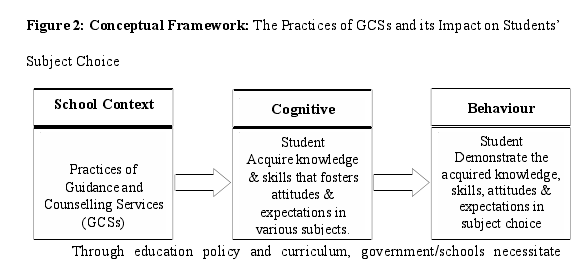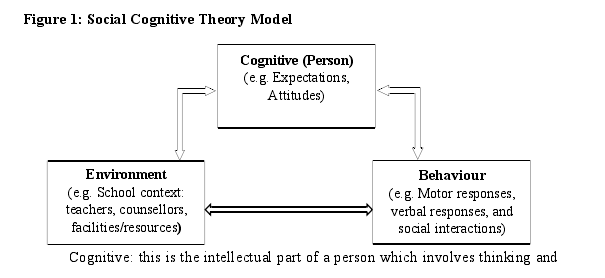本文是一篇教育论文,笔者认为本研究中的学生未能理解GCSs,因为根据上述原因,GCSs服务缺乏可信度。关于本研究中应用的SCT,该理论有助于指出,在培养学生的认知能力(结果预期、态度等)方面,GCSs实施的学校环境不符合标准,以获得与渴望的教育目标平行的学科选择知识和技能(行为复制)。此外,通过提供GCS,学生和教师辅导员之间缺乏社会学习互动是显而易见的,因为学生抱怨他们在寻求咨询时犹豫不决,原因包括教师辅导员的反应不令人信服、缺乏适当的咨询时间、,咨询师的承诺不足。因此,教师辅导员作为学生榜样的角色并不是很重要。根据抽样学校中注意到的实践GCS的现状,它建议或暗示这些学校的学生通过考虑来自家长、同伴学生、学科教师的其他帮助来选择学科,
CHAPTER ONE INTRODUCTION
1.1 Establishment and Development of GCSs in Tanzanian Schools
In Tanzania, a guidance and counselling curriculum was established in the 1960s. It was conducted in National Vocational Training Centres (NVTCs) as a special career subject dealing with career development (UNECA, 1986). The target was to instil a close relationship amongst industries and employers to uphold the opportunities of employment to students after finishing the school period. Through career selection and development, National Vocational Training Centres prepared booklets, brochures, magazines every year to disseminate information relating to various careers so that many students would be enrolled. Guidance and counselling deliberately supported students to build a good relationship with teachers and students to understand their roles during the training and at the labour market.
Nevertheless, the outbreak of Human Immuno Virus/Acquired Immuno Deficiency Syndrome (HIV/AIDS) in Tanzania between 1983/84 compelled the introduction of GCSs in secondary schools as an intervention service (World Health Organization, 2005). The mission was to provide quality and equitable access to counselling services on HIV/AIDS and life skills education. The main goal was to reduce the spread of HIV/AIDS among students in schools through the provision of relevant and improved availability and accessibility of psychosocial support services to all learners so that they can learn comfortably and effectively (MoEVT, 2011, p.35). Since then, remarkable education circulars on practices of GCSs in Tanzanian secondary schools became evident. For example, circular number 3 of (MoEC, 1993, 2000) and circular number 11 of (MoEC, 2002) detailed the development and practices of GCSs in Tanzania. Following the reformation of the education and training policy of 1995, another circular was released in 2007. Likewise, guidelines on Guidance and Counselling Services issued by (MoEVT, 2011) and (MoEST, 2020) reinforced the continued quality provision of GCSs in schools.
...........................
1.2 The Need of GCSs Regarding Students’ Subject Choice in Secondary Schools
Guidance and Counselling Services (GCSs) in schools are imperative for modelling students in fulfilling their aspired educational goals. For fruitful education outcomes, schools must have propitious guides for the implementation of the education curriculum which includes the incorporation of intervention strategies like GCSs to ameliorate students learning. According to Social Cognitive Theory (Bandura, 1986) that learning environments essentially should define suitably/support the purposes of education to be attained. So, services like guidance and counselling are vital to students in acquiring knowledge and skills that enable them to engage in self-directed learning, getting information on subject choices, daring to withstand schooling challenges, and finally excel in academics (DES, 2006, p. 18).
Too, SCT delineates that the learning context comprising of teachers and school counsellors actively plays as role models to affect students’ study behaviour more appropriately. The learning that incorporates Guidance and Counselling such as orientation services, information services, placement services, counselling services, assessment services, follow-up services, and remedial services should be an integral part of student’s educational pathways to develop academic competence and acquisition of study skills which helps in subject/course choice, management of study time, and avoidance of examination anxiety (Cooley, 2010; Coy, 2004). On the whole, cordial guidance and counselling harmonize students’ expectations and attitudes which ultimately help in setting realistic educational goals such as appropriately choice of subjects’ that link to students’ career aspirations. To accomplish this, a depiction is given that “Education systems need to prepare young people to be effective in applying what they know to ever-changing situations, expose them to relevant role models, and provide guidance that helps them discover their passions, where and how they can find or create a job” (Program for International Student Assessment-PISA, 2018). Therefore, for students to achieve their supreme educational goals, provision of GCSs should be done with effect students joins the school.
.......................
CHAPTER TWO LITERATURE REVIEW
2.1 The Current Situation of GCSs in Tanzanian Secondary Schools
Through the review of government documents on the practices of Guidance and Counselling Services, it is shown that provision of Guidance and Counselling Services in primary, secondary schools, and in teacher education training are all emphasized in the Education and Training Policy (ETP) to provide the first-rate services. It is stipulated that “the government will strengthen the provision of GCSs at all levels of education and training which meets students’ needs” (ETP, 2014, p. 34). This indicates the aspiration of the government to assist students in achieving their education goals.
However, the National Curriculum Framework for Basic and Teacher Education, and the National Strategy for Care and Support Services unveils that, guidance and counselling curriculum in primary schools secondary schools is to be integrated into existing education curriculum and subjects’ syllabi (MoEVT, 2011, p. 10; TIE, 2019, pp. 25-26). This point out that there is no independent guidance and counselling curriculum in schools.
As a result, topics related to guidance and counselling are merged into the subject syllabi like Biology and Civics in secondary schools (MoEVT, 2011), and these topics are taught to students as cross-cutting lessons (Human Rights Watch, 2017, p. 81). Due to this indistinctive guidance and counselling curriculum, the Ministry of Education Science and Technology (MoEST, 2020) issued a guide for guidance, counselling, and child protection for schools and teachers colleges in Tanzania which directs to establish and manage effectively the practices of GCSs as persuasive interventions to students schooling by demanding schools to allocate timetable for GCSs, ensuring facilities/resources and training to counsellors are available and giving them maximum cooperation in implementing the Guidance and Counselling Services (MoEST, 2020). In general, the current practices of Guidance and Counselling Services in Tanzanian schools as documented by (MoE ST, 2020) are executed by teacher counsellors who are appointed by heads of schools. These teacher counsellors in most schools lack training for the provision of an outstanding GCSs. Hence, they apply the knowledge and skills learned during teachers’ training in colleges/universities.
........................
2.2.0 The Major GCSs and their Significances on Student Academic Learning
Different scholars on the study of Guidance and Counselling Services in schools have established that these services have reputable implications for students learning outcomes. For example, Kemetse et al. (2018, pp. 198-199) in Ghana enumerated these services as orientation, information, appraisal, consultation, and follow-up services whereas Lunenburg (2010) in the United States of America emphasized the requisite Guidance and Counselling Services to be practiced in schools include information, placement, assessment, follow-up, and counselling services. Moreover, (Eremie & Jackson, 2019, p. 14; Orewere et al., 2020) in Nigeria, Solomon (2017, pp. 18-19) in Ethiopia, and (Anyi, 2017, pp. 12-13) in Cameroon have documented that the Guidance and Counselling Services that has practical significance on student academic learning include orientation, information, placement, appraisal, counselling, follow-up, evaluation, and referral services. Collectively, the aforementioned GCSs are imperative for cultivating students’ schooling. Their notable significances are presented hereunder;
Firstly, the practices of GCSs provide knowledge and skills that help students comprehend their academic capabilities, foresee their future studies, and hence career pathways. Through the help of school counsellors, students are stimulated to improve their educational goals hence pursuing their studies more effectually (Lunenburg, 2010; MoEST, 2020, p. 26; Nkechi et al., 2016).
Secondly, the Guidance and Counselling Services practiced in schools helps students to make pivotal academic decisions on various academic issues they encounter. For instance, to do subject choices, information on subject interrelations and their applications in various careers should be appropriately addressed through career Guidance and Counselling Services thereby enabling students to understand their education pathways (MoEST, 2020, p. 25; Orewere et al., 2020).

................................
CHAPTER THREE RESEARCH METHODOLOGY .................................. 27
3.0 Overview ....................................... 27
3.1 Research Approach ........................................... 27
3.2 Research Design ................................................ 27
CHAPTER FOUR FINDINGS ........................................ 39
4.0 Overview ............................................. 39
4.1.0 Practices of Guidance and Counselling Services in Community Secondary Schools ..... 39
4.1.1 Orientation Service ...................................... 40
4.1.2 Information Service ............................................ 42
CHAPTER FIVE DISCUSSION, CONCLUSION, LIMITATIONS, AND RECOMMENDATIONS .. 63 5.0 Overview ..................... 63
5.1 Practices of Guidance and Counselling Services in Community Secondary Schools ..... 63
5.2 Social-Contextual Impact of Practiced GCSs on Students’ Subject Choice ...... 72
CHAPTER FOUR FINDINGS
4.0 Overview
This chapter comprised the findings of the study based on the research objectives and methodology. The objectives of the study required to ascertain how GCSs are practiced in CSS, and to comprehend the impact of practiced GCSs on students’ subject choice. The first research objective has one category; the practices of Guidance and Counselling Services in Community Secondary School. This category consists of seven sub-categories which are orientation, placement, counselling, information, assessment, follow-up, and remedial services as interrogated in the interview guide. Also, the second research objective has one category; the impact of practiced GCSs on students’ subject choice. This category is divided into two categories which are; the social-contextual and cognitive impact of practiced GCSs on students’ subject choice. The social-contextual impact of practiced GCSs on students’ subject choice yielded one theme whereas the cognitive impact of practiced GCSs on students’ subject choice emerged into two themes; the effective and ineffective cognitive impact of practiced GCSs on students’ subject choice. These themes have sub-themes as indicated in figure 3. The chapter ends up by underlining the main findings of the study.

...........................
CHAPTER FIVE DISCUSSION, CONCLUSION, LIMITATIONS, AND RECOMMENDATIONS
5.0 Overview
The current chapter embraced discussion of the findings presented in chapter four based on the research objectives which deemed to ascertain how GCSs are practiced in Community Secondary Schools and to comprehend the impact of practiced GCSs on students’ subject choice. The themes emerged in this study included; practices of Guidance and Counselling Services. This is comprised of seven categories which are orientation, placement, counselling, information, assessment, follow-up, and remedial services. Another theme is; the impact of practiced GCSs on students’ subject choice. This is categorized into two themes which are; the social-contextual impact of practiced GCSs on students’ subject choice and the cognitive impact of practiced GCSs on students’ subject choice. The social-contextual impact of practiced GCSs on students’ subject choice has only one sub-theme whereas the cognitive impact of practiced GCSs on students’ subject choice is further categorized into the effective and ineffective cognitive impact of practiced GCSs on students’ subject choice. The discussion has also encompassed the reasons for the ineffective impact of practiced GCSs on students’ subject choice. All over the discussion, literature review, Social Cognitive Theory, and the conceptual framework have been considered. To end with, the conclusion, limitations, and recommendations of the study findings are spotlighted.
reference(omitted)
